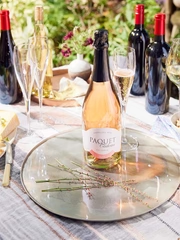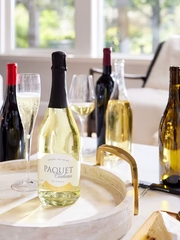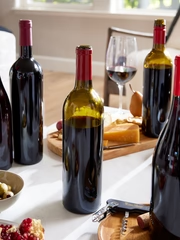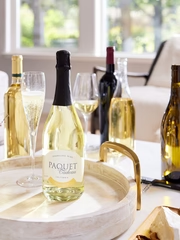 The main idea behind sparkling wine is to create a reaction in the bottle that will provide effervescence when opened. The pressure of the carbonation level determines the style of bubbly.
Perlant or Beady wines have less than one atmosphere of pressure (14.7 psi). The presence of bubbles is visible on the side of the glass after pouring.
Semi-sparkling wines reach one to two and a half atmospheres (14.7 – 37 psi) of pressure.
Sparkling, such as Crémant, Spumante or Champagne, are at three or more atmospheres (up to 70 psi) and can be labeled as sparkling wines.
Nowadays there are two major sparkling wine production methods with their own technical challenges: the Traditional Method and the Tank Method, also called the Charmat Method.
The Traditional Method
The most important facet of the Traditional Method is that the transformation from a still to a sparkling wine occurs entirely inside the bottle. Grapes with a higher than usual acidity are picked. A dry wine is produced. The winemaker blends several base wines together to get the final sparkling wine blend.
Yeast and sugars are added to the wine, called cuvée, to start the second fermentation. It is then bottled and topped with crown caps, just like a beer bottle. The second fermentation will add extra alcohol and some CO2. This process creates a cloudy wine while the yeasts are active. Wines are aged on their lees (deposits of residual yeast). Champagne requires at least 15 months. Cava requires only a minimum of 9 months.
The main idea behind sparkling wine is to create a reaction in the bottle that will provide effervescence when opened. The pressure of the carbonation level determines the style of bubbly.
Perlant or Beady wines have less than one atmosphere of pressure (14.7 psi). The presence of bubbles is visible on the side of the glass after pouring.
Semi-sparkling wines reach one to two and a half atmospheres (14.7 – 37 psi) of pressure.
Sparkling, such as Crémant, Spumante or Champagne, are at three or more atmospheres (up to 70 psi) and can be labeled as sparkling wines.
Nowadays there are two major sparkling wine production methods with their own technical challenges: the Traditional Method and the Tank Method, also called the Charmat Method.
The Traditional Method
The most important facet of the Traditional Method is that the transformation from a still to a sparkling wine occurs entirely inside the bottle. Grapes with a higher than usual acidity are picked. A dry wine is produced. The winemaker blends several base wines together to get the final sparkling wine blend.
Yeast and sugars are added to the wine, called cuvée, to start the second fermentation. It is then bottled and topped with crown caps, just like a beer bottle. The second fermentation will add extra alcohol and some CO2. This process creates a cloudy wine while the yeasts are active. Wines are aged on their lees (deposits of residual yeast). Champagne requires at least 15 months. Cava requires only a minimum of 9 months.
 These large bottle racks are used during the process of riddling. The lees settle in the bottle upside down, collecting in the neck of the bottle.
The bottles are placed upside down into freezing liquid, which causes the yeast to freeze in the neck of the bottle. The crown cap is then popped off momentarily, which allows the frozen chunk of lees to shoot out of the pressurized bottle. After being topped up with a little sugar, a practice called dosage, the bottles are then corked, wired, labeled and ready for sale.
The Tank Method or Charmat Method
Unlike the Traditional Method, the Charmat Method uses the tank as the vessel for fermentation. Initially, the bottle is removed from the equation. Base wines are added into a tank along with a sugar and yeast mixture which is called tirage. Tank Method sparkling wines have much more freshly-made characters with stronger yeasty flavors.
Though this is the method that a lot of large Italian brands are using in mass-produced wines, it is still used for fine sparkling winemaking.
These large bottle racks are used during the process of riddling. The lees settle in the bottle upside down, collecting in the neck of the bottle.
The bottles are placed upside down into freezing liquid, which causes the yeast to freeze in the neck of the bottle. The crown cap is then popped off momentarily, which allows the frozen chunk of lees to shoot out of the pressurized bottle. After being topped up with a little sugar, a practice called dosage, the bottles are then corked, wired, labeled and ready for sale.
The Tank Method or Charmat Method
Unlike the Traditional Method, the Charmat Method uses the tank as the vessel for fermentation. Initially, the bottle is removed from the equation. Base wines are added into a tank along with a sugar and yeast mixture which is called tirage. Tank Method sparkling wines have much more freshly-made characters with stronger yeasty flavors.
Though this is the method that a lot of large Italian brands are using in mass-produced wines, it is still used for fine sparkling winemaking.
 The Charmat Method is the method that we are using at our partner winery, making it possible to offer you a complete portfolio of styles with three flavorful sparkling wines.
WineShop At Home is proud to produce the Talmage Cellars and le Cadeau wines for you to enjoy every day and especially during the holiday season. Pop the cork and enjoy!
The Charmat Method is the method that we are using at our partner winery, making it possible to offer you a complete portfolio of styles with three flavorful sparkling wines.
WineShop At Home is proud to produce the Talmage Cellars and le Cadeau wines for you to enjoy every day and especially during the holiday season. Pop the cork and enjoy!





